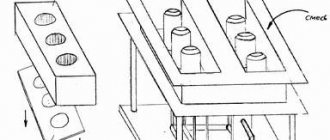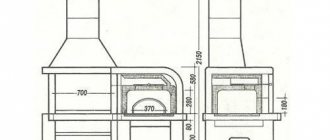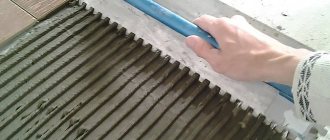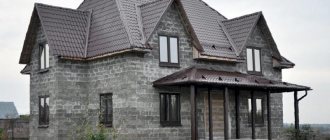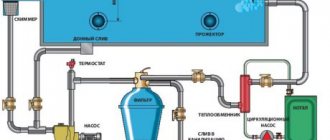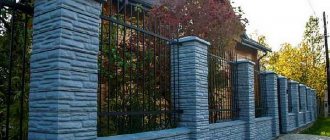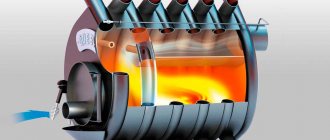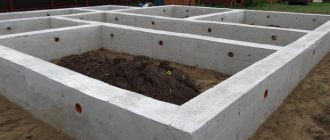- How to choose the right size of gas blocks
- Indented finish
Interior partitions have to be erected not only in newly built private houses. Today, high-rise buildings often provide individual apartment layouts, which the new owner can implement at his own discretion. Most often, a 100 mm thick gas block is used for this purpose, which will be discussed further.
Selection of aerated concrete blocks
Two important parameters that are taken into account when choosing blocks are the geometric dimensions and strength of the product.
The thickness of interior partitions made of aerated concrete blocks is determined depending on the length of the wall and the height from the floor to the interfloor ceiling:
- up to 2.5 choose blocks with a thickness of 75 mm;
- from 2.5 to 3 m - 100 mm;
- from 3 to 5 m - from 200 mm.
If the wall will bear a load in the form of any heavy objects, products with a thickness of 75 mm are not used. They are also not used if doorways will be made in the wall.
A partition made of aerated block with a thickness of 150–200 mm good sound insulation properties . If the parameter is important, do not use 75 and 100 mm products. An aerated partition block with a density of D500 or D600 is the optimal solution if the wall will be subject to a load of up to 150 kg . Lightweight partitions can be made from material with characteristic D350 or D400.
Soundproofing of aerated concrete
Although sellers of gas silicate blocks talk about high sound insulation performance, they greatly exaggerate. Even a standard block 200 mm thick conducts sounds and noise well, and thinner partition blocks even more so.
Comparative characteristics of sound insulation of partitions made of different materials
According to standards, the sound resistance of partitions should not be lower than 43 dB, and it is better if it is higher than 50 dB. This will provide you with silence.
Sound insulation standards for different rooms
To get an idea of how “noisy” gas silicate blocks are, we present a table with standard indicators of sound resistance of blocks of different densities and different thicknesses.
Sound absorption coefficient of aerated concrete blocks
As you can see with the block, at 100mm thick it falls slightly short of the lowest requirement. Therefore, when finishing aerated concrete, you can increase the thickness of the finishing layer in order to “reach” the standard. If normal sound insulation is required, the walls are additionally sheathed with mineral wool. This material is not soundproofing, but it reduces noise by approximately 50%. As a result, sounds are almost inaudible. Specialized soundproofing materials have the best performance, but when choosing them, you need to look at their vapor permeability characteristics so as not to trap moisture inside the gas silicate.
If you need absolutely “quiet” walls, experts advise installing two thin partitions with a distance of 60–90 mm, which should be filled with sound-absorbing material.
Tools and materials
To build the wall and finish it you will need:
- drill for fastening the corner at the junction of the partition with the walls;
- a dispensing carriage that evenly distributes a thin layer of glue over the surface of the block or a notched trowel if the amount of work is small;
- saw for cutting blocks;
- building level and square, painting cord with paint powder:
- rubber mallet;
- brush and grater for cellular concrete;
- container for mixing the adhesive composition.
For masonry, purchase the required amount of glue , the consumption of which is indicated on the packaging and may vary from one manufacturer to another.
Each block at the point of contact with the load-bearing walls, ceiling and floor is secured using a galvanized strip or hangers ; they are purchased after accurate calculations of the material. Fastening is carried out using special dowels.
If the span of the partition is more than 3 meters, it needs to be reinforced with a polymer rod. The reinforcement is laid in 3–4 rows; based on this calculation, consumables are purchased.
It is undesirable to use metal fittings. When it interacts with the lime present in the block, the steel rusts and brown spots appear on the wall.
Requirements for internal walls made of foam concrete
The main features of an internal wall. She:
- is not a carrier, i.e. the floors do not rest on it, but on the main walls;
- transfers the load to the floor or foundation of the building;
- adjacent to one or more adjacent walls.
The following requirements apply to internal walls made of aerated concrete:
- Strength. They must withstand vertical loads from hanging furniture, consumer electronics, etc.
- Sustainability. The walls must be firmly connected to the base, and there must also be a strong connection between individual elements and adjacent structures.
- Light weight. The load on the floor should not exceed the critical load. The porosity of aerated concrete ensures a minimum density of 300-1200 kg/m3.
- Good sound insulation. Construction rules SP 51.13330.2011 determine the sound insulation index between adjacent rooms in an apartment to be at least 52 dB.
- Thermal insulation. The temperature difference between individual rooms in an apartment or house should not exceed 10°C.
- Small dimensions. The wall should not be too thick - you should save as much usable living space as possible.
- Fire safety. The minimum fire resistance of the partition (fire propagation delay time) should not exceed 15 minutes.
- Environmental Safety. A wall made of foam concrete at any operating temperature should not emit harmful substances into the room air.
- Low cost. The cost of foam concrete should not exceed the cost of alternative materials for construction.
Step-by-step instruction
Self-construction of a partition consists of several technological operations :
- markings;
- waterproofing;
- installation of anti-vibration pads;
- laying blocks and attaching them to walls;
- reinforcement according to the layout of the rows;
- production of doorways, through niches and lintels over openings;
- arrangement of connections to the ceiling;
- finishing.
Each stage is performed in compliance with technology.
Marking
It is convenient to use a laser level for marking.
Most often, aerated concrete partitions are built after the construction of the building frame . If done earlier, at the stage of installing the interfloor ceiling, damage to the blocks or destruction of the entire partition may occur.
Use a laser plane builder or make do with a bubble level and plumb line:
- At the intersection of the ceiling and opposite walls, mark two points . One of the sides of the partition will be located in these places in the future.
- Use a paint cord to mark a straight line connecting the previously marked points.
- Using a plumb line, project the markings onto the floor .
- The upper and lower marks are connected by a line, which will indicate the junction of the partition with the walls.
Valera
The voice of the construction guru
Ask a Question
To prevent mistakes, check the accuracy of drawing the line on the floor. To do this, control measurements are taken several times across the entire width of the room using a plumb line. The marks on the ceiling and floor must match along the entire length.
Waterproofing and vibration prevention
If the partition is installed in a damp room, waterproof the wall from the floor. The surface is cleaned of dirt, concrete layers left by masonry mortar. Use roofing felt or other bitumen-based material. It is simply laid on the floor or glued with rubber-bitumen mastic for reliability.
A vibration damping layer is attached over the waterproofing and along the walls . It serves as protection against cracking of blocks and plaster from vibrations, and also reduces the level of noise penetrating into neighboring rooms.
as a vibration damping pad :
- mineral wool cardboard;
- sheets of expanded polystyrene up to 5 mm thick;
- pieces of cork lining;
- soft fibreboard.
If the gasket is not installed on the walls in advance, after the construction of the partition is completed, the cracks are foamed with assembly adhesive for aerated concrete blocks.
Laying the first and subsequent rows
If for horizontal alignment it is necessary to lay a layer of glue more than 20 mm, use a cement-sand mortar.
The level of adjacent blocks must be maintained when laying the first row ; glue consumption and, to a greater extent, the reliability of the entire structure depend on this.
Algorithm for laying aerated concrete blocks:
- A straight strip is nailed along the mark on the wall , which will provide convenience when aligning the partition vertically.
- Along the floor markings, a construction mesh made of polymer or metal - this will reduce the likelihood of cracking the walls.
- Work begins from the load-bearing wall , at a distance of 1–5 mm from which the first block is installed. For leveling, apply gentle blows with a rubber hammer.
- After laying the first row, the mortar is allowed to harden , since when installing the second row, movements are possible that violate the geometry of the wall.
- The block is attached to the wall using soft metal suspension. Rigid corners and rods embedded in a load-bearing wall are not used, since vibrations will gradually destroy the block.
- To ensure ligation of rows , one block is sawed in the middle. If there is a doorway in the partition, then markings for cutting are carried out taking it into account. In some cases, the block will have to be cut differently.
- Before laying each next row, the previous one is leveled with metal floats . Protrusions and irregularities between adjacent blocks are cut off. The surface should be flat and horizontal, which will prevent excessive stress in the blocks.
- Stretch the marking cord to facilitate alignment of the second and each subsequent row.
- A special adhesive for aerated blocks is used as a binding solution . The composition is distributed using a purchased or homemade carriage. After each application, the body of the device is cleaned of glue, as it sets quickly.
- After three rows lay the first reinforcement layer. A recess is made in the surface into which glue is placed. Reinforcement is placed in the groove along the entire length of the partition and the recess is filled with glue.
- Continue laying out rows until they reach the ceiling.
- Between the last row and the ceiling a compensation gap of 15 - 20 mm is left, which is filled with polyurethane foam upon completion of construction.
The blocks are adjusted to size using a file. Cutting with an angle grinder creates a lot of dust, which is difficult to completely remove before applying glue to the block.
The procedure for making openings
Layout diagram
Aerated concrete partitions are not load-bearing walls, therefore reinforced concrete lintels are not installed above doorways .
To place blocks above standard doors with a width of 600 to 800 mm, use a steel corner with shelves of 30–50 mm. The corners should be 50–60 cm longer than the opening to ensure reliable intersection with the walls of the partition.
If the width of the span requires the installation of two blocks, they are cut so that the seam is above the middle of the doorway.
For long arches, they use not a corner, but a channel with a width suitable for the block. The channel is embedded in the wall. Supports are installed under the arch partition so that the channel or corner does not bend. The support is removed after the glue has dried.
An alternative option for arranging the floor is the production of a reinforced belt :
- A wooden box is made as wide as a partition and 4–5 cm high.
- Lay three reinforcement rods with a diameter of at least 12 mm.
- Fill the box with glue or cement-sand mortar.
- Install aerated concrete blocks without waiting for the solution to dry.
- The formwork is removed after 2-3 days, when the glue has completely hardened.
The rows above the lintel are installed last.
Before finishing, if necessary, the partition is grooved, electrical wires are laid, and socket boxes are installed.
Cladding of aerated block
Since partition blocks are intended for internal use, we will talk about how and with what such walls can be finished indoors. In principle, there are no restrictions on the use of this or that type of finish. The main thing, when carrying out work, is to take into account such features of the base as increased moisture absorption if the finish is wet, and the need for the correct selection of fasteners if the material is to be mounted on the sheathing.
- But first, a few words about how you can use masonry without finishing at all. We have already mentioned that bare brickwork is in fashion. But with the same success, you can use the texture of block masonry in design. An aerated block is best suited for this purpose, since it has the most accurate geometry and thin and neat seams - provided, of course, that the material was autoclaved and mounted not with mortar, but with glue. And of course, the blocks themselves must be intact, without cracks, chips or broken corners.
- The use of bare block masonry fits into the concepts of many styles: industrial, antique, Mediterranean, techno, hi-tech. The wall, which is supposed to be left unfinished, must be sanded, thoroughly cleaned of dust and treated in several layers with a water repellent.
- As an option, you can apply decorative painting directly on top of the masonry, without intermediate plastering. For example, take paint with a pearl sheen or a metallic sheen. You can just use white - although it will cover the texture of the concrete, it will leave visible the seams that geometrically outline the wall.
- If you still want to traditionally plaster the masonry, you can use solutions based on any type of binder (except clay) cement, gypsum, lime, polymer and their various combinations. But in bathrooms it is better to use cement and polymer compounds, on top of which you can both glue tiles and perform painting work. In this case, it is better to use silicone-based paint.
- Tiles are generally a very popular material, and are installed not only in bathrooms and kitchens. Well-designed cladding with an interesting texture looks great in any other room. Take the same brick texture. Why unnecessarily weigh down the partition by installing a brick and aerated block pie, if the desired texture can be achieved with complete certainty using tiles?
It is made from clinker, ceramics, polymer concrete, and gypsum. All this is installed using the wet method, after preliminary leveling with cement putty. If low-density or non-autoclaved blocks were used for masonry, the aerated block wall should be reinforced with fiberglass mesh before gluing the tiles. Compliance with the golden rule of construction, which states that the foundation must be stronger than the coating, has not yet been canceled.
Indented finish
As for finishing walls using the frame method, you need to follow a few simple rules. It is better to install the lathing not from a metal profile, but from wood. The bars can be fixed with nails 100-150 mm long, driving them through the wood into the masonry at an angle of 30 degrees. This fastening resists a pullout force of at least 50 kgf, even if the density of aerated blocks is only 400 kg/m³. The optimal size of slats for guides is 40-20 mm.
If you still assemble the sheathing from a galvanized profile, then you cannot do without the use of special fasteners. These are polymer dowels with external threads, which are screwed into pre-drilled holes. Most of them have a fairly high resistance to tearing, which makes it possible not only to install the cladding, but also to hang heavy objects.
It is better not to begin installation of the cladding immediately after the construction of the partition; the masonry should be given time to dry and gain working humidity. Otherwise, the bars may rot, and moisture may condense on the profile. It is also possible to “seal” the partition on both sides moisture-proof no earlier than the moisture content of the masonry has normalized.
Installing jumpers
Standard factory-made block
Reinforced aerated concrete lintels can be of two types - ready-made, factory-made and lintels assembled at the construction site.
Lintels reinforced from aerated concrete
Assembled - because to make the lintels you will need U-blocks and a reinforcement cage. U-shaped blocks are parts of permanent formwork made of aerated concrete. The class of concrete and the diameter of the reinforcement for filling the formwork are selected taking into account the design loads and the characteristics of the region where construction is being carried out.
Construction for laying the frame
Reinforced aerated concrete lintels are made as follows - instructions:
- We measure the required length of the jumper. We assemble and glue the blocks together; wait for it to dry. In the opening where the lintel will be installed, we place a support made of auxiliary material (insurance), and place a glued lintel (U-blocks) on top. We install the prepared reinforcement frame inside the permanent formwork and pour the concrete mixture. After gaining strength - remove the support. We use it.
Ready-made U-block formwork
Ready-made aerated concrete lintels - dimensions, design and product advantages
Aerated concrete lintels, manufactured by specialized enterprises in accordance with the requirements of the current standard, are widely popular among developers. In cross section, such a beam has a rectangular shape. The beam structure is reinforced with a reinforcement cage with an anti-corrosion coating. There are arrows on the surface of the lintel indicating how to correctly position the beam during installation.
With a standard beam height of 12.4 cm, the products differ in the following dimensions:
- length of 1.3-3 m;
- width ranging from 11.5 cm to 17.5 cm.
The simplest and most common design is an aerated concrete beam. An aerated concrete beam is the simplest and most common structure, which has a set of advantages. Main advantages:
- increased strength characteristics provided by a reinforced reinforcement frame. The lintel does not crack under loads;
- reduced jumper weight. Thanks to the use of porous concrete in the manufacture of the beam, the mass of the element is reduced and the load on the aerated concrete box and foundation is reduced;
- compliance of the structure of the aerated concrete beam with the characteristics of the blocks used. There is no need for additional thermal insulation of the structure due to identical thermal efficiency indicators.
Technique for installing reinforced aerated concrete lintels
Installation of aerated concrete beams is carried out after the reinforcement of aerated concrete blocks in the area of a window or doorway is completed. Before installation operations begin, beams with dimensions corresponding to the distance between the support blocks in the reception area should be selected
It is also important to use a jumper of the required width, ensuring maximum contact area with the surface of the gas blocks
After the final curing of the adhesive composition, laying aerated concrete blocks on the lintel is allowed
When carrying out activities for the installation of aerated concrete beams, perform the work according to the following algorithm:
- Place the adhesive compound on the supporting surface of the blocks.
- Lift the jumper to the installation location.
- Install the beam on the opening, focusing on the direction of the arrow.
- Install a second jumper if necessary.
After completing the installation operations, ensure that the upper plane of the beams is at the same level using a rubber hammer. To remove sagging and local irregularities, use an aerated concrete plane. Laying aerated concrete blocks on the lintel is allowed after the final curing of the adhesive composition.
Recommendations from experts
Partitions are usually erected after the external walls are completed. If the length exceeds 8 m and the height is 3.5 m, the frame must be additionally reinforced with reinforced concrete elements. When using cement-sand mortar as a masonry mixture, it is necessary to provide a layer with a thickness of within 3 mm. It is important to exclude mutual deformation stresses between products.
In addition to the compensation gap at the top, it is necessary to ensure that the edges of the new structure meet the load-bearing fences. The partition will need to be connected with reinforcing elements, which are installed at a distance of a meter from each other. In order not to measure the correct displacement of blocks in horizontal rows, you need to focus on half the length of the product. Usually the last block in a row is not the size of the space for it. You can trim the products with a hacksaw. During masonry work, moisture should be avoided.
You should not blindly trust the seller when purchasing material. This is especially true if high density material is required. When you weigh the block, you will understand what purpose it has. If the thickness is 10 cm and the weight varies from 14 to 18 kg, this is a construction material. If the weight turns out to be less, they are trying to sell you thermal insulation products with low strength.
Existing disadvantages
- High hygroscopicity, requiring reliable waterproofing to prevent the accumulation of moisture in concrete pores. Let me give you an interesting experiment: a test sample with a density of 800 kg/m3 was left in a state of complete immersion in water for 18 hours, during which time its mass increased by 47%. Eight days later, after being removed from the water, the weight returned to its original weight.
- Susceptibility to cracking due to low prismatic strength. Easily leveled by plastering.
- The appearance of a large amount of dust during drilling and sawing.
- When installing heavy parts on walls, you will need to use special anchors.
The existing disadvantages are more than offset by numerous advantages, which makes the use of the material more and more in demand.
